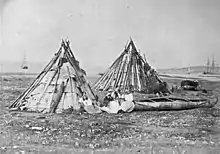Miꞌkmaꞌki
Miꞌkmaꞌki or Miꞌgmaꞌgi is the traditional and current territories or country of the Miꞌkmaq people. It is shared by an inter-Nation forum between Miꞌkmaq First Nations and is divided into seven geographical and traditional districts, with an eighth representing Taqamkuk today. Miꞌkmaꞌki is one of the confederate countries within Wabanaki.
Miꞌkmaꞌki | |
|---|---|
| Pre-contact–1867 (as a State) | |
.svg.png.webp) Flag | |
 Seven Districts of Miꞌkmaꞌki excluding Taqamkuk | |
| Status | Confederated Districts of Wabanaki |
| Capital | Mniku, Unamaꞌkik |
| Common languages | Miꞌkmawiꞌsimk |
| Demonym(s) | Miꞌkmaq |
| Government | Santeꞌ Mawioꞌmi / Miꞌkmawey Mawioꞌmi |
| Kji Sagamaw | |
• unknown-1611 | Henri Membertou |
• 1792-1818 | Francis Peck |
• 1818-1842 | Michael Tooma |
• 1842-1869 | Frank Tooma Jr. |
| Sagamaw | |
| Putus | |
| History | |
• Established | Pre-contact |
| 1497 | |
• Exclusion from the Treaty of Utrecht | 1713 |
| 1725 | |
| 1867 (as a State) | |
| Population | |
• pre-1500 | 35,000-75,000[2] |
• 1500 | 4,500 |
• 1750 | 3,000 |
• 1900 | 4,000 |
• 2016 | 58,763[3] |
| Currency | Wabanaki Wampum |
| Today part of | |
Each district was autonomous, headed by a Sagamaw, who would gather alongside Wampum readers and knowledge keepers called Putus, a women's council and the Kji Sagamaw, or Grand Chief, to form the Santeꞌ or Miꞌkmawey Mawioꞌmi (Grand Council).[2] The seat of the Santeꞌ Mawioꞌmi is at Mniku in Unamaꞌkik and still functions as the capital today in the Potlotek reserve.
Following contact, Miꞌkmaꞌki was colonized by the French and British Nova Scotia colonies and their competing claims for the land. Siding with the French, the Miꞌkmaq fought alongside other Wabanaki troops during the global wars between 1688-1763. The European powers divided Miꞌkmaꞌki in the treaties of Utrecht (1715) and Paris (1763). The British claimed Miꞌkmaꞌki as their possession by conquest and the defeated Miꞌkmaq signed the Peace and Friendship Treaties to end hostilities and encourage cooperation between the Wabanaki countries and the British and ensure the survival of the Miꞌkmaq people whose numbers had dwindled to a few thousand from disease and starvation. The power held within Miꞌkmaꞌki faded further after the Confederation of Canada united the colonies and Canada passed the Indian Act, and the loss of autonomous governance.
Today, the Santeꞌ Mawioꞌmi functions solely as a spiritual and dialogue forum, with oversight held by the Government of Canada through individual Miꞌkmaq First Nations instead of Miꞌkmaꞌki and the Kji Sagamaw. The traditional lands' sovereignty has never been ceded by the Miꞌkmaq,[4] although legal arguments have been made that the Peace and Friendship treaties legitimized the takeover of the land by Britain.
Governance

Traditionally each district had its own independent government. Those governments were composed of a chief and a council. The council included the band chiefs, elders and other important leaders. The role of the councils was similar to those of any independent government and included to edict laws, establish a justice system, divide the territory for hunting and fishing, make war and search for peace.
The overarching Grand Council Santeꞌ Mawioꞌmi was composed of the keptinaq (captains), the district chiefs. The Grand Council also included elders, putus (historians reading the belts) and a Council of women. The Grand Council was headed by a grand chief who was one of the district chiefs, generally the Unamaꞌkik chief. Succession was hereditary. The seat of the Grand Council was generally on Unamaꞌkik (Cape Breton Island).[5]
Districts
The eight districts (names are given in the Franci-Smith orthography with the Listuguj orthography in brackets) are:
References
- "Miꞌkmaw Time Line". Cape Breton University. Retrieved 26 September 2017.
- McMillan, Leslie Jane (December 1996). "Miꞌkmawey Mawioꞌmi: Changing Roles of the Miꞌkmaq Grand Council From the Early Seventeenth Century to the Present" (PDF). Dalhousie University: 219. Retrieved 26 September 2017. Cite journal requires
|journal=(help) - Harold Franklin, McGee Jr (13 August 2008). "Miꞌkmaq". Historica Canadian. Retrieved 26 September 2017.
- Paul 2000, p. 160.
- "Miꞌkmaq". Intercontinental Cry. Retrieved 2 December 2016..
- Paul, Daniel N. (2000). We Were Not The Savages: A Miꞌkmaq Perspective on the Collision Between European and Native American Civilizations. Fernwood Publishing.CS1 maint: ref=harv (link)